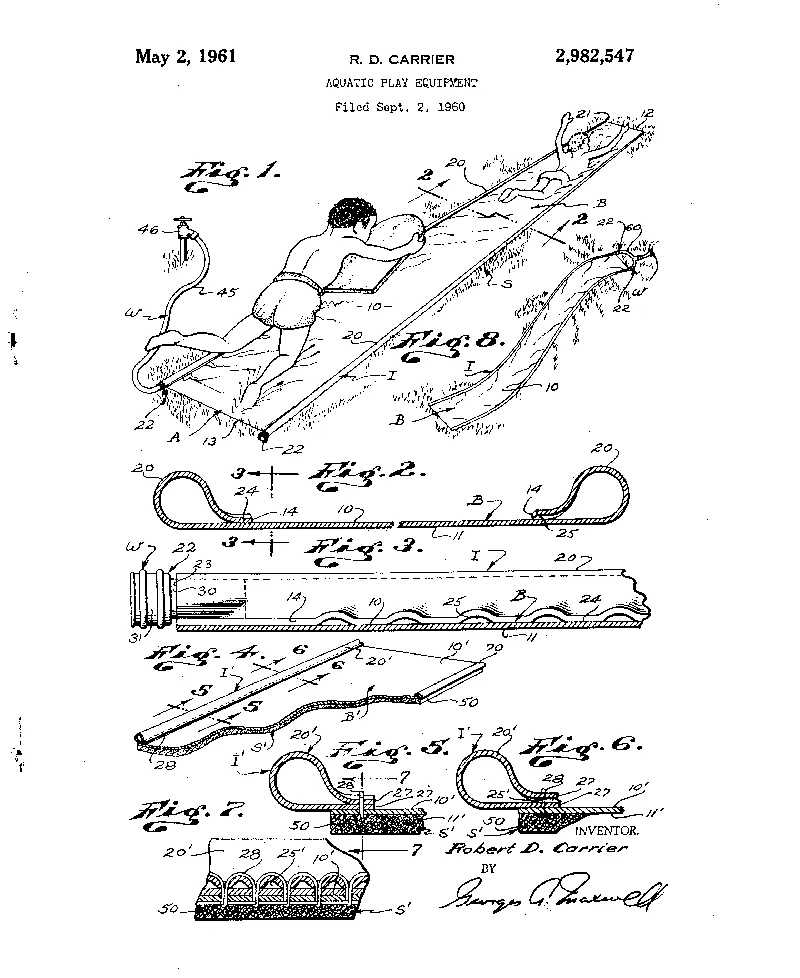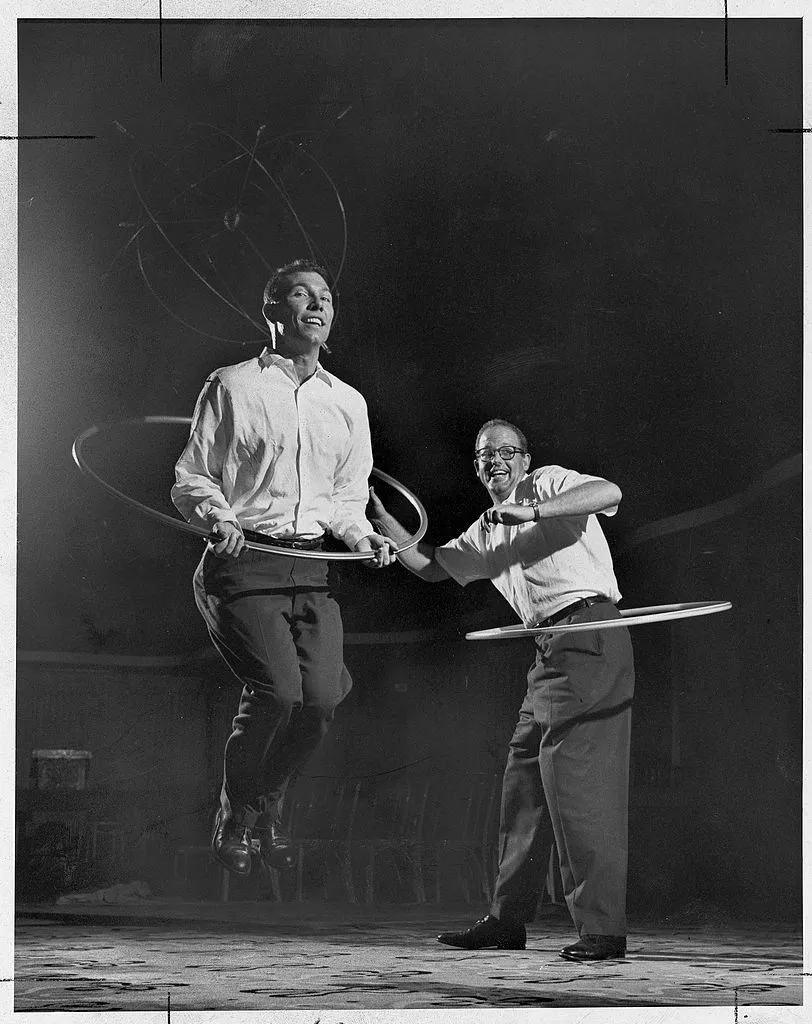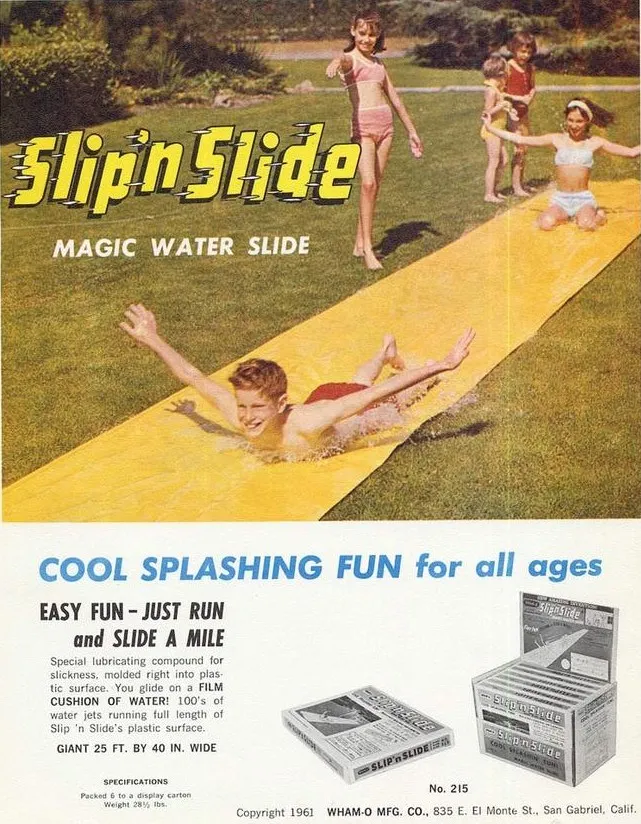The Accidental Invention of the Slip ‘N Slide
A young boy’s summer antics 60 years ago inspired his father to create the timeless backyard water toy
/https://tf-cmsv2-smithsonianmag-media.s3.amazonaws.com/filer/04/9e/049e5e02-cd8b-4943-982c-5a5f544bd64c/girl_on_slip_n_slide-resize.jpg)
It was August 2000, and I’d been picking noodles out of my hair for days. The seniors at my high school decided the incoming freshmen needed a bonding experience, and so they laid out at least a dozen bright yellow plastic slides across the soccer fields, dumped Kraft macaroni and cheese on top, and turned on the hoses. We definitely bonded.
While my fondest memory of the Slip ‘N Slide is messier than most, it nevertheless connects me to generations of kids who have spent their summers skidding through backyards, soaked with delight in their very own water world. It is this shared experience—the visceral response to seeing that plastic chute atop the lawn—that makes Slip ‘N Slide one of the most enduring toys of all time.
The invention of the Slip ‘N Slide is, perhaps unsurprisingly, the result of some childhood shenanigans. It was the summer of 1960, and Robert Carrier had returned home from work to find his 10-year-old son, Mike, and his friends careening down their driveway in Lakewood, California. To escape the heat, the boys had turned the hose on the painted concrete, creating a cool, slippery surface to play on.
“Mike told me the story of his dad saying, ‘well you guys are going to kill yourself sliding on concrete’,” says Tim Walsh, game inventor and author of Timeless Toys: Classic Toys and the Playmakers Who Created Them.
The next day, Carrier, who worked as an upholsterer with a boat-manufacturing company, brought home a 50-foot roll of Naugahyde, which he unraveled on the driveway. The vinyl-coated, waterproof fabric was a vast improvement—slicker and safer—over the perilous concrete. But Carrier’s son had given him an idea.

According to Carrier’s 1961 patent , the “aquatic play equipment” was a portable surface for the “sport” of body planing. From his original strip of Naugahyde, Carrier took a ream of the plastic material and sewed a tube into the side, forming an “irrigating duct” to which a hose could attach. The duct had punctures along the length of it, from which water could be released via pressure from the hose. Seams stitched across the length of the fabric at regular intervals also carried water laterally, wetting the repellant surface but not making it soggy.
“It’s very easy to dismiss,” says Walsh. “The best inventions are so simple that people are like, ‘Wow, why didn't I think of that?’ But if you look at the patent, I mean it is really genius. You attach the hose to one end and then sew the other end shut so that there's pressure, and then you put spaces in between the stitches so that water literally shoots out every inch and lubricates the entire surface of the slide.”
Others saw beauty in Carrier’s design, too. Namely, the successful toy manufacturer Wham-O, founded by two University of Southern California graduates in 1948. According to Walsh, Carrier showed his invention to coworkers, and found out that his boss “knew someone at a toy company up in San Gabriel.” Trading out Naugahyde for a less-expensive vinyl plastic and shortening the length to 25 feet, Wham-O released the “new amazing invention, the Wham-O Slip ‘N Slide Magic Waterslide” at the Toy Fair trade show in New York City in February 1961. By September of that year, more than 300,000 slides had been sold.

“I think it is telling that the Slip ‘N Slide comes from Wham-O, a company that seems to have a particularly sensitive finger on the American pulse, as the people who brought you the Frisbee, the Hula Hoop and the SuperBall,” says Chris Bensch, Vice President for Collections at The Strong National Museum of Play. “They just seem to get it, and capture something that isn't quite like anything you've seen before, but suddenly you've got to have.”
Wham-O’s early TV advertisements made the Slip ‘N Slide a summer must-have. Commercials featuring kids flying across their lawns brought the toy—an ordinary package on the shelf—to life. “IT’S CRAZY… people scoot like seals!” declared the box, but that was hard to imagine until seeing the “wet, wild ride” on the screen. Even in the blurred black and white of a commercial from the 1960s, the footage of happy kids hydroplaning while friends lined up for a turn made a sure sell. “It makes you go like a jet,” said the voice over. “It’s cool, summer splashing fun…the famous Slip ‘N Slide by Wham-O!”
But another element of Slip ‘N Slide’s appeal was and continues to be its accessibility.
“All we wanted as kids was ‘please, can we please have a pool,’” says Walsh. “But we were this blue-collar family and there was no way we were going to afford a pool. The Slip ‘N Slide was a very inexpensive way to have fun and cool off.” At $9.95, Slip ‘N Slide was much cheaper than day passes for the family to the neighborhood pool.
Today, a Slip ‘N Slide costs about $35, depending on the model. The original has been modified to include options like double sliding lanes for racing and various inflatable add-ons to slide through, such as a shark jaw, touchdown goal post, “splash dunk” ball net and a palm tree oasis. As of 2011, more than 30 million Slip ‘N Slides had been sold, and it won’t be surprising if 2020’s “quarantine summer” sees even higher than usual sales. Daniel Modlin, commerce staff writer for the Daily Beast, recently declared, "I'm getting my Slip ‘N Slide before they're all sold out, and I recommend you do the same thing."
Of course, over the years other companies have created competing versions of the slide, some even resulting in legal disputes. Though the Slip ‘N Slide name has become synonymous with the product and those like it, now, none except Wham-O’s can be the trademark yellow. “Remember,” wrote Wham-O on the toy’s 50th anniversary, “if it’s not yellow—it’s not a Slip ‘N Slide.”

A 1993 recall reflected concerns over the potential danger of the slides, reporting that between 1973 and 1991 seven adults and a 13-year-old who used WHAM-O slides suffered neck injuries, quadriplegia or paraplegia.
“It was off the market for while… [Wham-O] kept shortening the length of it, so if you're a full grown-adult and you can sprint way faster than a kid and you weigh 100 pounds more than a kid and the thing is short, and you stop short, bad things are going to happen,” says Walsh.
Package labeling now includes an age limit of 12, and explicitly states that the toy is not for adult use. The design also now features an inflatable pool-like reservoir at the end of the slide, intended to prevent hard stops and flips that could cause injury.
Despite these controversies, Slip ‘N Slide’s staying power is strong, and in 2014, more than 40 years after Carrier’s original design first hit the market, the toy was nominated for induction into The Strong’s National Toy Hall of Fame. Slip ‘N Slide has yet to win the honor, but given its iconic status Bensch says he is “confident it will have its day.”
As for Slip ‘N Slide’s inventor, Robert Carrier used royalties earned from his creation to start an aircraft interior business. When Kransco bought Wham-O in the mid-1980s and re-released the toy, Carrier negotiated a full buy-out. “I believe I’m not speaking out of turn when I say Slip ‘N Slide is the most profitable line in Wham-O,” says Walsh. Robert Carrier passed away in 2002, but his legacy lives on every summer in grass stains and laughter as kids “slip, slide and away.”
“My dad always told me that I was the inventor of Slip ‘N Slide because of what we did in that driveway,” Mike Carrier once told Walsh, who wrote a book about Wham-O in 2008. “Of course, he was the real inventor, and a great father.”
/https://tf-cmsv2-smithsonianmag-media.s3.amazonaws.com/accounts/headshot/Sexton_Remy.jpg)


/https://tf-cmsv2-smithsonianmag-media.s3.amazonaws.com/accounts/headshot/Sexton_Remy.jpg)